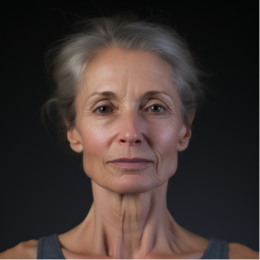What Are the 5 Symptoms of Osteoporosis? (All You Need to Know)

Osteoporosis is a common yet often overlooked bone disease affecting millions worldwide. It is characterized by the loss of bone density, making the bones fragile and prone to fractures.
Although osteoporosis can develop silently over many years, there are several key symptoms that individuals should be aware of to seek timely diagnosis and treatment.
In this article, we will explore symptoms of osteoporosis, shedding light on this condition and encouraging proactive healthcare.
What Are the Symptoms of Osteoporosis?
1. Fractures That Occur Easily
One of the telltale signs of osteoporosis is the occurrence of fractures with minimal trauma or even without any apparent cause. Common sites for fractures include the wrists, hips, and spine. Individuals with osteoporosis may experience fractures during simple activities such as lifting a heavy object, bending, or even sneezing. These fractures can cause significant pain, loss of mobility, and a decrease in the quality of life.
Statistics:
- According to the International Osteoporosis Foundation, osteoporosis causes more than 8.9 million fractures yearly.
- In the United States alone, osteoporotic fractures account for over 1.5 million fractures annually, with hip fractures being the most severe and debilitating.
2. Back Pain and a Stooped Posture
Osteoporosis can lead to compression fractures in the spine, resulting in back pain and a gradual loss of height. As the vertebrae collapse, individuals may develop a stooped or hunched posture, known as kyphosis or dowager’s hump. This change in posture not only affects physical appearance but also increases the risk of further fractures.
Statistics:
- Approximately 75% of all osteoporotic fractures occur in women aged 60 and older, with vertebral fractures being the most common.
3. Loss of Bone Mass and Decreased Height
As osteoporosis progresses, individuals may experience a noticeable loss of bone mass. This can lead to a decrease in height, as the spinal vertebrae become compressed and the bones in the legs and arms weaken. Regular check-ups and bone density scans can help detect and monitor the progression of osteoporosis, allowing for appropriate intervention.
Statistics:
- Women are more susceptible to osteoporosis than men, and estrogen deficiency after menopause is a significant risk factor. It is estimated that one in three women over the age of 50 will experience osteoporotic fractures.
- Men are also affected by osteoporosis, with an estimated one in five men over the age of 50 experiencing fractures due to this condition.
4. Brittle Nails and Receding Gums
Osteoporosis can affect more than just the bones; it can also impact other parts of the body. Brittle nails that break easily and receding gums are potential symptoms of osteoporosis. These manifestations can occur due to the lack of essential nutrients reaching these tissues as a result of decreased bone mass and compromised bone remodeling.
Statistics:
- Studies have shown a connection between osteoporosis and periodontitis, a severe gum infection. It is estimated that individuals with osteoporosis are three times more likely to experience tooth loss due to periodontal disease.
5. Limited Range of Motion and Muscle Weakness
As bones become weaker and more prone to fractures, individuals with osteoporosis may experience a limited range of motion and muscle weakness. Simple tasks that require balance, coordination, and strength, such as climbing stairs or getting up from a chair, can become challenging. Under the guidance of healthcare professionals, regular exercise can help improve bone density and muscle strength, reducing the risk of falls and fractures.
Statistics:
- Approximately 20% of seniors who suffer a hip fracture due to osteoporosis die within one year due to complications, including pneumonia, blood clots, and infections.
How Do You Get Osteoporosis?

Osteoporosis can develop due to various factors, including age, genetics, lifestyle choices, and certain medical conditions. As individuals age, bone density naturally decreases. However, some individuals experience accelerated bone loss, leading to osteoporosis.
Additionally, certain medical conditions and medications can contribute to the development of this condition. Hormonal imbalances, such as decreased estrogen in women during menopause and low testosterone in men, can also increase the risk of osteoporosis.
Who Is at Risk for Osteoporosis?
While osteoporosis can affect both men and women, certain factors increase the risk for this condition. Some of the key risk factors include:
- Age: The risk of osteoporosis increases with age, with older adults being more susceptible to bone loss.
- Gender: Women are at a higher risk of developing osteoporosis, especially after menopause, due to the decline in estrogen levels.
- Family history: A family history of osteoporosis or fractures may increase an individual’s risk.
- Lifestyle factors: Poor nutrition, lack of exercise, smoking, excessive alcohol consumption, and a sedentary lifestyle can contribute to the development of osteoporosis.
- Certain medical conditions: Conditions such as rheumatoid arthritis, inflammatory bowel disease, celiac disease, and hormonal disorders can increase the risk of osteoporosis.
Conclusion
The five primary symptoms of osteoporosis include fractures that occur easily, back pain and a stooped posture, loss of bone mass and decreased height, brittle nails and receding gums, and limited range of motion and muscle weakness.
Remember, if you experience any of these symptoms or fall into the high-risk category, it is important to consult with a healthcare professional for evaluation and appropriate management.
References:
- International Osteoporosis Foundation. (n.d.). Facts and Statistics.
- National Osteoporosis Foundation. (n.d.). What is Osteoporosis, and What Causes It?
- Mayo Clinic. (2021). Osteoporosis.
- U.S. Department of Health and Human Services, Office on Women’s Health. (2020). Osteoporosis.
- International Osteoporosis Foundation. (n.d.). Women and Osteoporosis.
- National Institute of Arthritis and Musculoskeletal and Skin Diseases. (2019)





